Tsoulfanidis N. Measurement and detection of radiation
Подождите немного. Документ загружается.

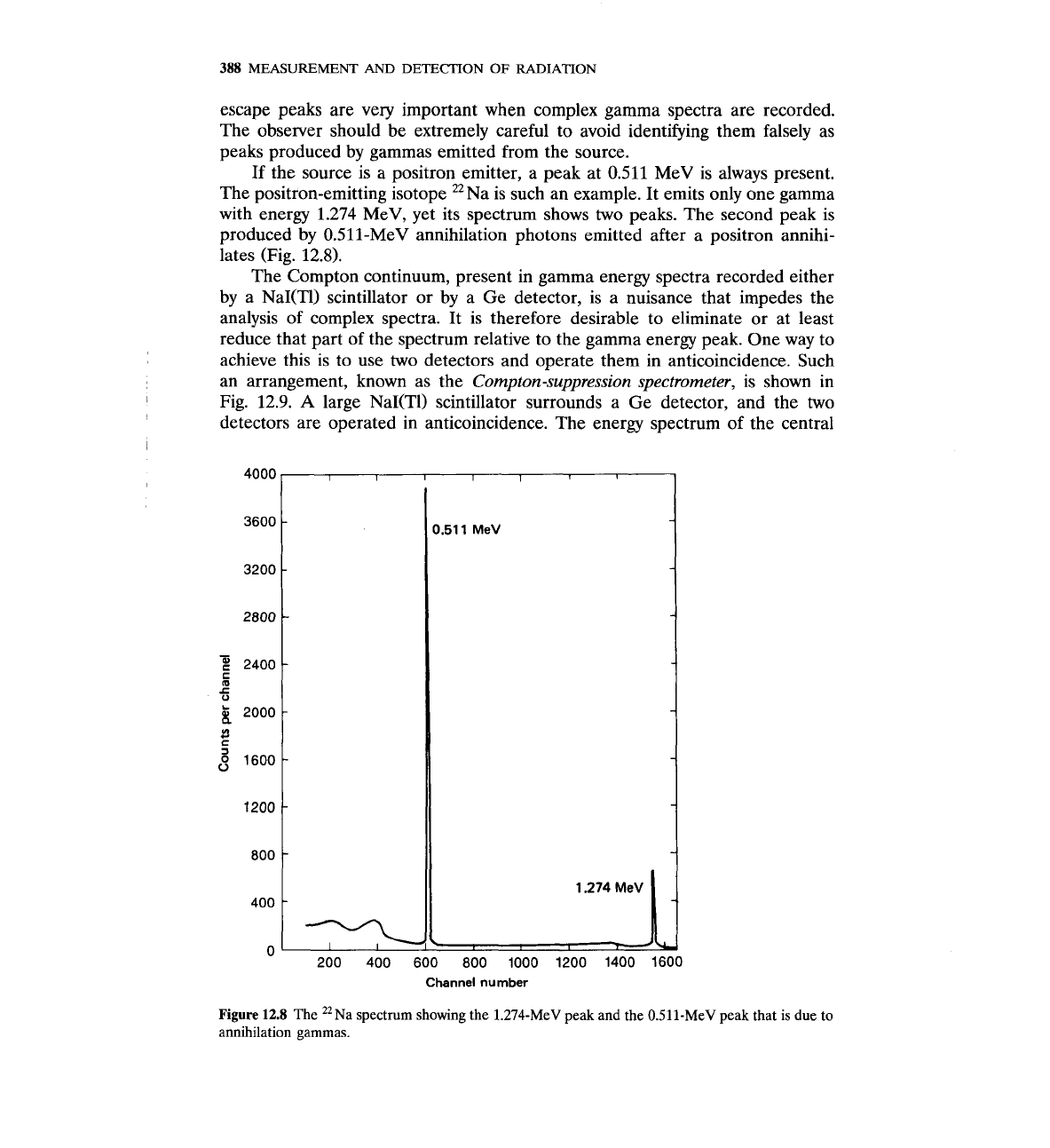
388
MEASUREMENT
AND DETECTION OF RADIATION
escape peaks are very important when complex gamma spectra are recorded.
The observer should be extremely careful to avoid identifying them falsely as
peaks produced by gammas emitted from the source.
If the source is a positron emitter, a peak at
0.511
MeV is always present.
The positron-emitting isotope '*Na is such an example. It emits only one gamma
with energy 1.274 MeV, yet its spectrum shows two peaks. The second peak is
produced by 0.511-MeV annihilation photons emitted after a positron annihi-
lates (Fig. 12.8).
The Compton continuum, present in gamma energy spectra recorded either
by a NaI(T1) scintillator or by a Ge detector, is a nuisance that impedes the
analysis of complex spectra. It is therefore desirable to eliminate or at least
reduce that part of the spectrum relative to the gamma energy peak. One way to
achieve this is to use two detectors and operate them in anticoincidence. Such
an arrangement, known as the
Compton-suppression spectrometer,
is shown in
Fig. 12.9.
A
large NaI(T1) scintillator surrounds a Ge detector, and the two
detectors are operated in anticoincidence. The energy spectrum of the central
1.51
1
MeV
Channel number
Figure
12.8
The ''~a spectrum showing the 1.274-MeV peak and the 0.511-MeV peak that is due to
annihilation gammas.
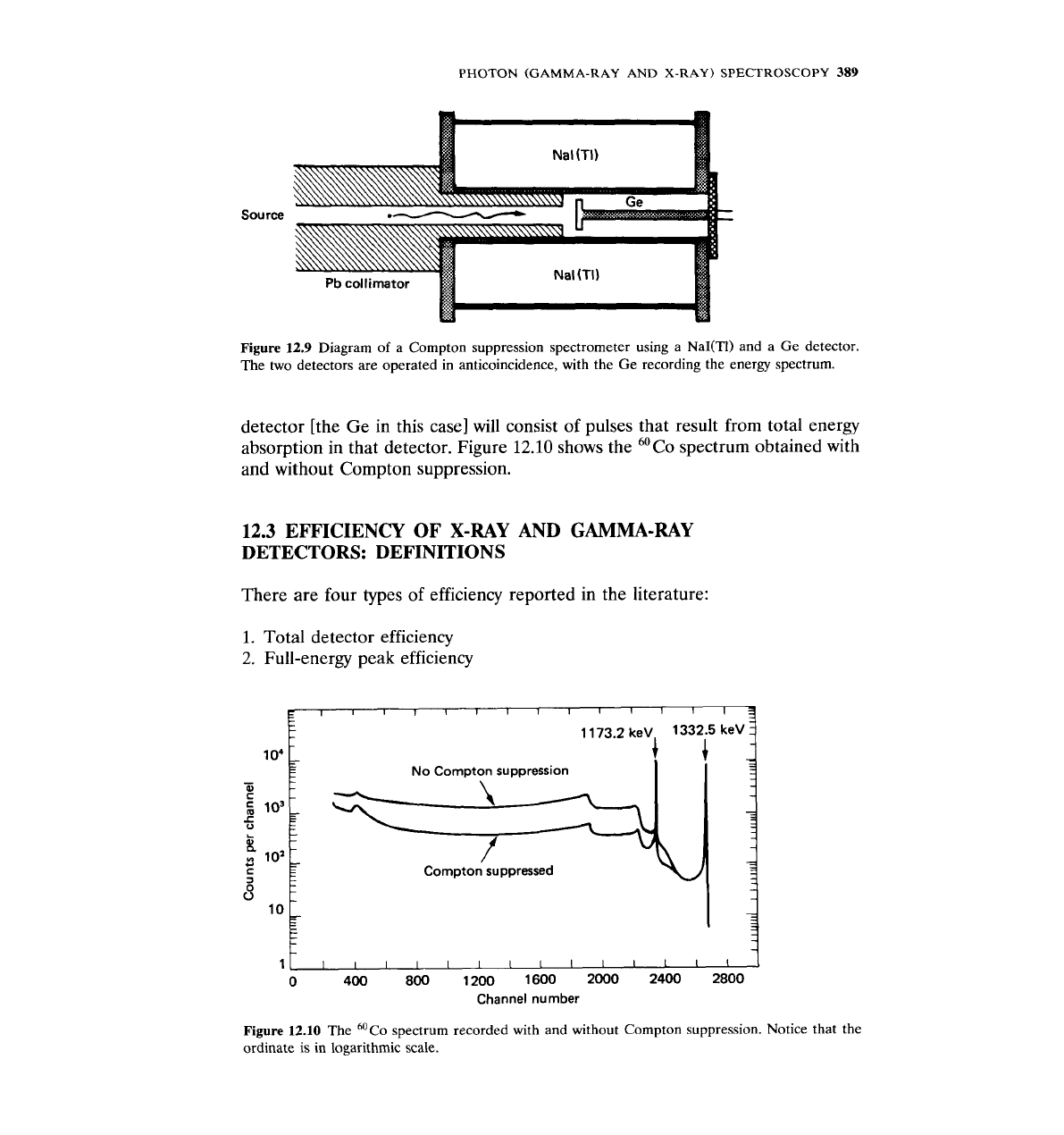
PHOTON
(GAMMA-RAY
AND
X-RAY)
SPECTROSCOPY
389
Source
Pb
collimator
BJ
1"01,11,
Figure
12.9
Diagram of a Compton suppression spectrometer using a NaI(T1) and a Ge detector.
The two detectors are operated in anticoincidence, with the Ge recording the energy spectrum.
detector [the Ge in this case] will consist of pulses that result from total energy
absorption in that detector. Figure
12.10
shows the 60Co spectrum obtained with
and without Compton suppression.
12.3
EFFICIENCY
OF
X-RAY
AND
GAMMA-RAY
DETECTORS: DEFINITIONS
There are four types of efficiency reported in the literature:
1.
Total detector efficiency
2.
Full-energy peak efficiency
lo4
-
-
-
- -
No Compton suppression
+
-
-
-
0)
-
g
lo3
-
C
I
=
-
1
Compton suppressed
-
10
1
IIIIIIIIIIIII~
0
400
800 1200 1600 2000
2400
2800
Channel number
Figure
12.10
The
'OCO
spectrum recorded with and without Compton suppression. Notice that the
ordinate
is
in logarithmic scale.
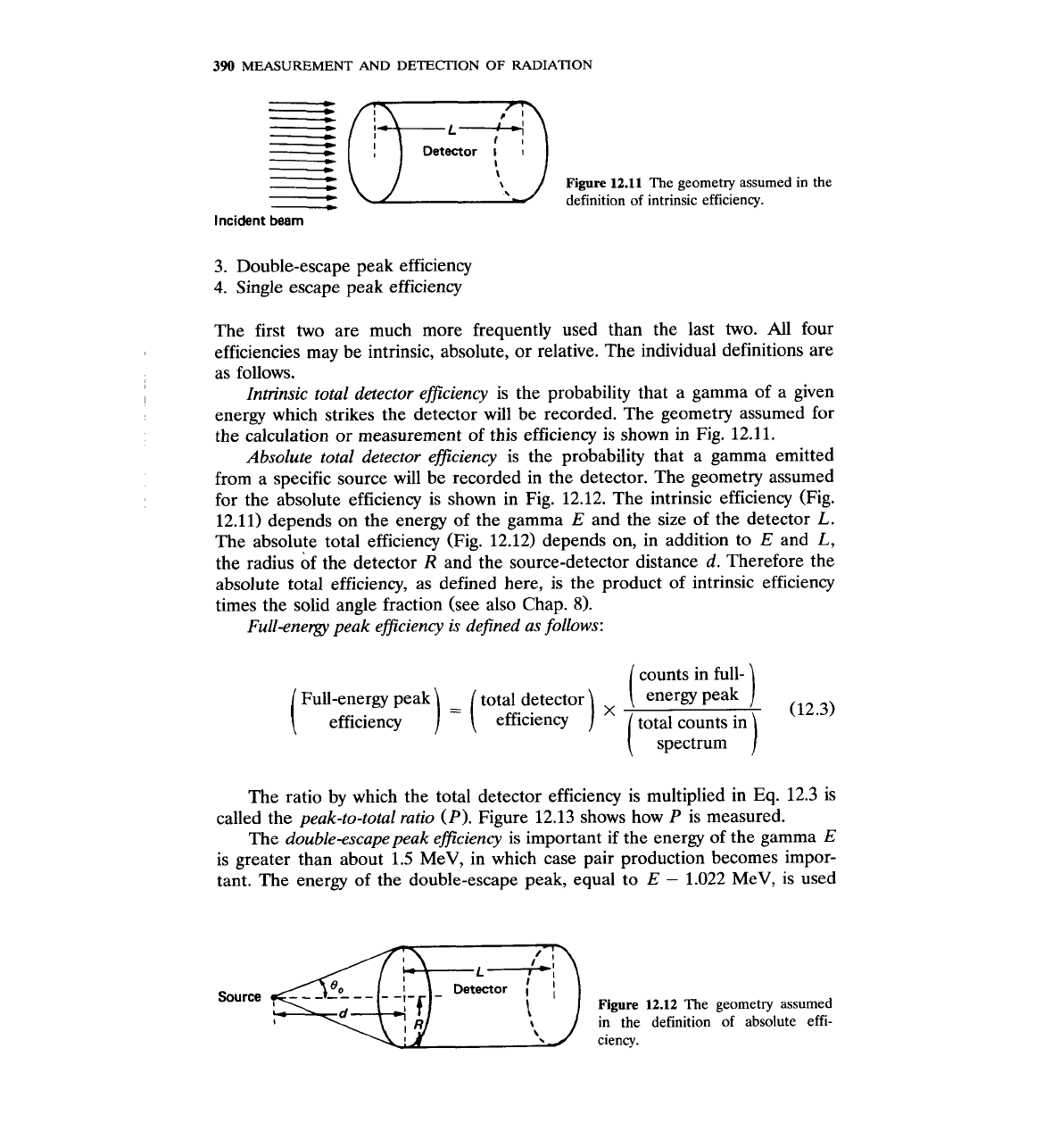
390
MEASUREMENT
AND
DETECTION
OF
RADIATION
-
1
-
1
Figure
12.11
The geometry assumed in the
-
8
-
definition of intrinsic efficiency.
l
ncident
beam
3.
Double-escape peak efficiency
4.
Single escape peak efficiency
The first two are much more frequently used than the last two. All four
efficiencies may be intrinsic, absolute, or relative. The individual definitions are
as follows.
Intrinsic total detector eficiency
is the probability that a gamma of a given
energy which strikes the detector will be recorded. The geometry assumed for
the calculation or measurement of this efficiency is shown in Fig. 12.11.
Absolute total detector eficiency
is the probability that a gamma emitted
from a specific source will be recorded in the detector. The geometry assumed
for the absolute efficiency is shown in Fig. 12.12. The intrinsic efficiency (Fig.
12.11) depends on the energy of the gamma
E
and the size of the detector
L.
The absolute total efficiency (Fig. 12.12) depends on, in addition to
E
and
L,
the radius of the detector
R
and the source-detector distance
d.
Therefore the
absolute total efficiency, as defined here, is the product of intrinsic efficiency
times the solid angle fraction (see also Chap.
8).
Full-enetgy peak eficiency is defined as follows:
counts in full-
(
Full-energy peak total detector energy peak
efficiency efficiency total counts in
(12.1)
spectrum
I
The ratio by which the total detector efficiency is multiplied in Eq.
12.3
is
called the
peak-to-total ratio
(P).
Figure 12.13 shows how
P
is measured.
The
double-escapepeak efficiency
is important if the energy of the gamma
E
is greater than about 1.5 MeV, in which case pair production becomes impor-
tant. The energy of the double-escape peak, equal to
E
-
1.022 MeV, is used
Figure
12.12
The geometry assumed
in the definition of absolute effi-
ciency.
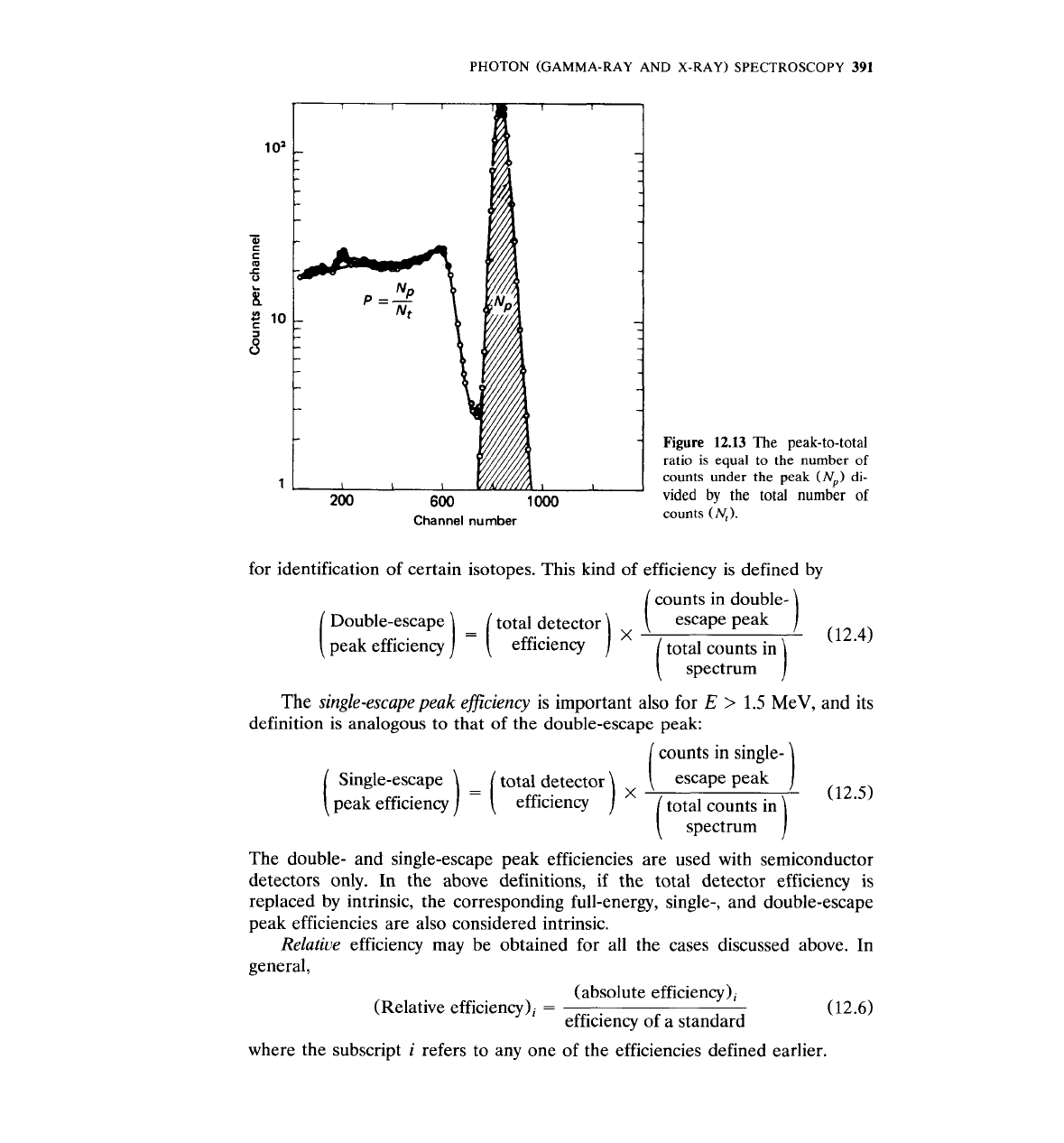
PHOTON
(GAMMA-RAY
AND
X-RAY)
SPECTROSCOPY
391
Figure
12.13
The
peak-to-total
ratio
is
equal to the number
of
counts under the
peak
(N,)
di-
vided
by
the total
number
of
Channel
number
counts
(N,).
for identification of certain isotopes. This kind of efficiency is defined by
(
counts in double-
\
Double-escape
\
escape peak
peak efficiency efficiency
(12.4)
(
total counts in
\
\
spectrum
The
single-escape peak
efficiency
is important also for
E
>
1.5
MeV, and its
definition is analogous to that of the double-escape peak:
(
counts in single-
\
Single-escape escape peak
1
peak efficiency efficiency
(12.5)
total counts in
spectrum
The double- and single-escape peak efficiencies are used with semiconductor
detectors only.
In
the above definitions, if the total detector efficiency is
replaced by intrinsic, the corresponding full-energy, single-, and double-escape
peak efficiencies are also considered intrinsic.
Relative
efficiency may be obtained for all the cases discussed above. In
general,
(absolute effi~iency)~
(Relative efficien~y)~
=
(12.6)
efficiency of a standard
where the subscript
i
refers to any one of the efficiencies defined earlier.
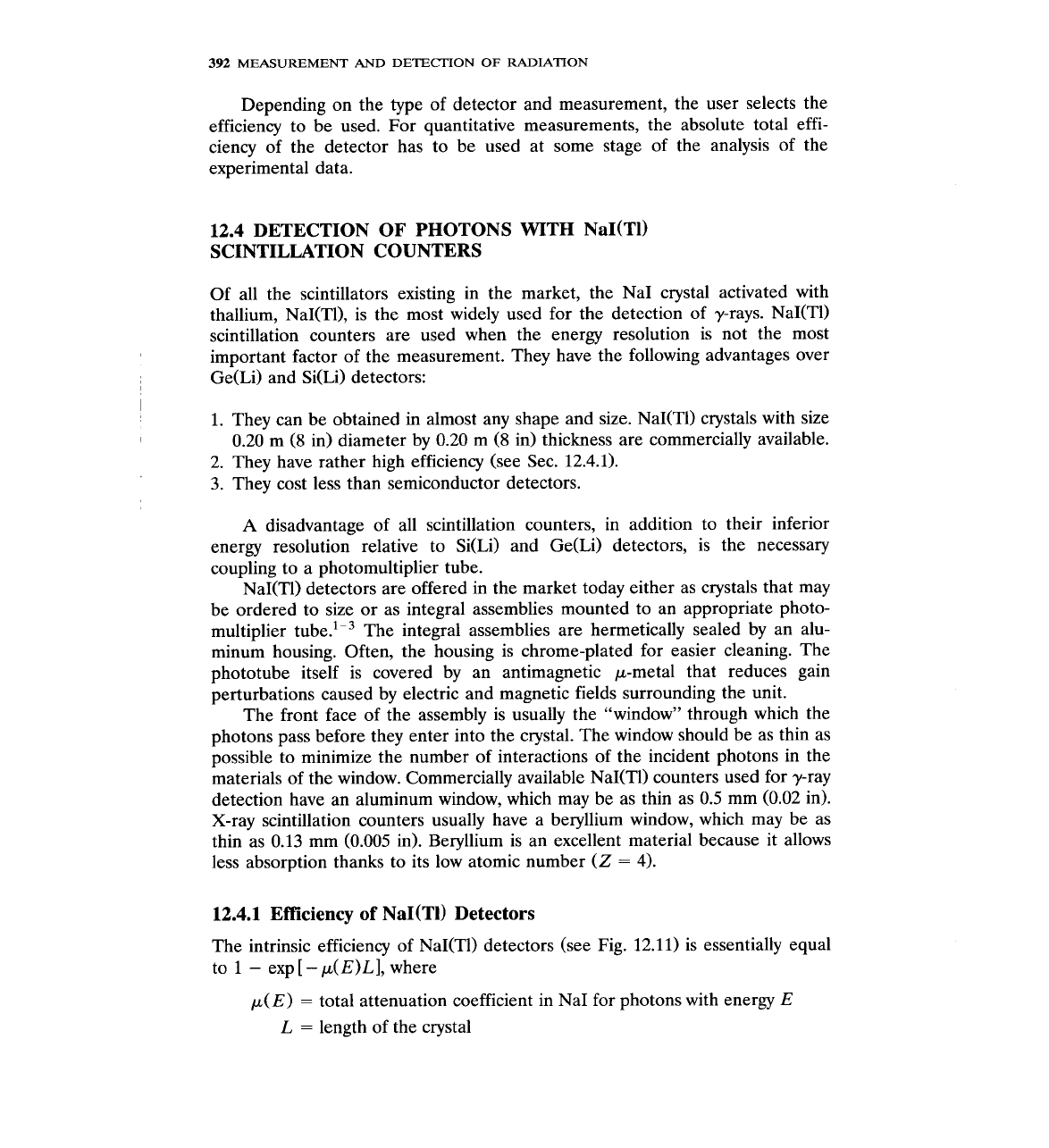
392
MEASUREMENT AND DETECTION OF RADIATION
Depending on the type of detector and measurement, the user selects the
efficiency to be used. For quantitative measurements, the absolute total effi-
ciency of the detector has to be used at some stage of the analysis of the
experimental data.
12.4 DETECTION OF PHOTONS WITH NaI(T1)
SCINTILLATION COUNTERS
Of all the scintillators existing in the market, the NaI crystal activated with
thallium, NaI(Tl), is the most widely used for the detection of y-rays. NaI(T1)
scintillation counters are used when the energy resolution is not the most
important factor of the measurement. They have the following advantages over
Ge(Li) and Si(Li) detectors:
1. They can be obtained in almost any shape and size. NaI(T1) crystals with size
0.20 m (8 in) diameter by 0.20 m (8 in) thickness are commercially available.
2. They have rather high efficiency (see Sec. 12.4.1).
3. They cost less than semiconductor detectors.
A
disadvantage of all scintillation counters, in addition to their inferior
energy resolution relative to Si(Li) and Ge(Li) detectors, is the necessary
coupling to a photomultiplier tube.
NaI(T1) detectors are offered in the market today either as crystals that may
be ordered to size or as integral assemblies mounted to an appropriate photo-
multiplier tube.'-3 The integral assemblies are hermetically sealed by an alu-
minum housing. Often, the housing is chrome-plated for easier cleaning. The
phototube itself is covered by an antimagnetic p-metal that reduces gain
perturbations caused by electric and magnetic fields surrounding the unit.
The front face of the assembly is usually the "window" through which the
photons pass before they enter into the crystal. The window should be as thin as
possible to minimize the number of interactions of the incident photons in the
materials of the window. Commercially available
NaI(T1) counters used for y-ray
detection have an aluminum window, which may be as thin as 0.5 mm (0.02 in).
X-ray scintillation counters usually have a beryllium window, which may be as
thin as 0.13 mm (0.005 in). Beryllium is an excellent material because it allows
less absorption thanks to its low atomic number
(Z
=
4).
12.4.1 Efficiency of NaI(T1) Detectors
The intrinsic efficiency of NaI(T1) detectors (see Fig. 12.11) is essentially equal
to
1
-
exp[-p(E)L], where
p(E)
=
total attenuation coefficient in NaI for photons with energy
E
L
=
length of the crystal
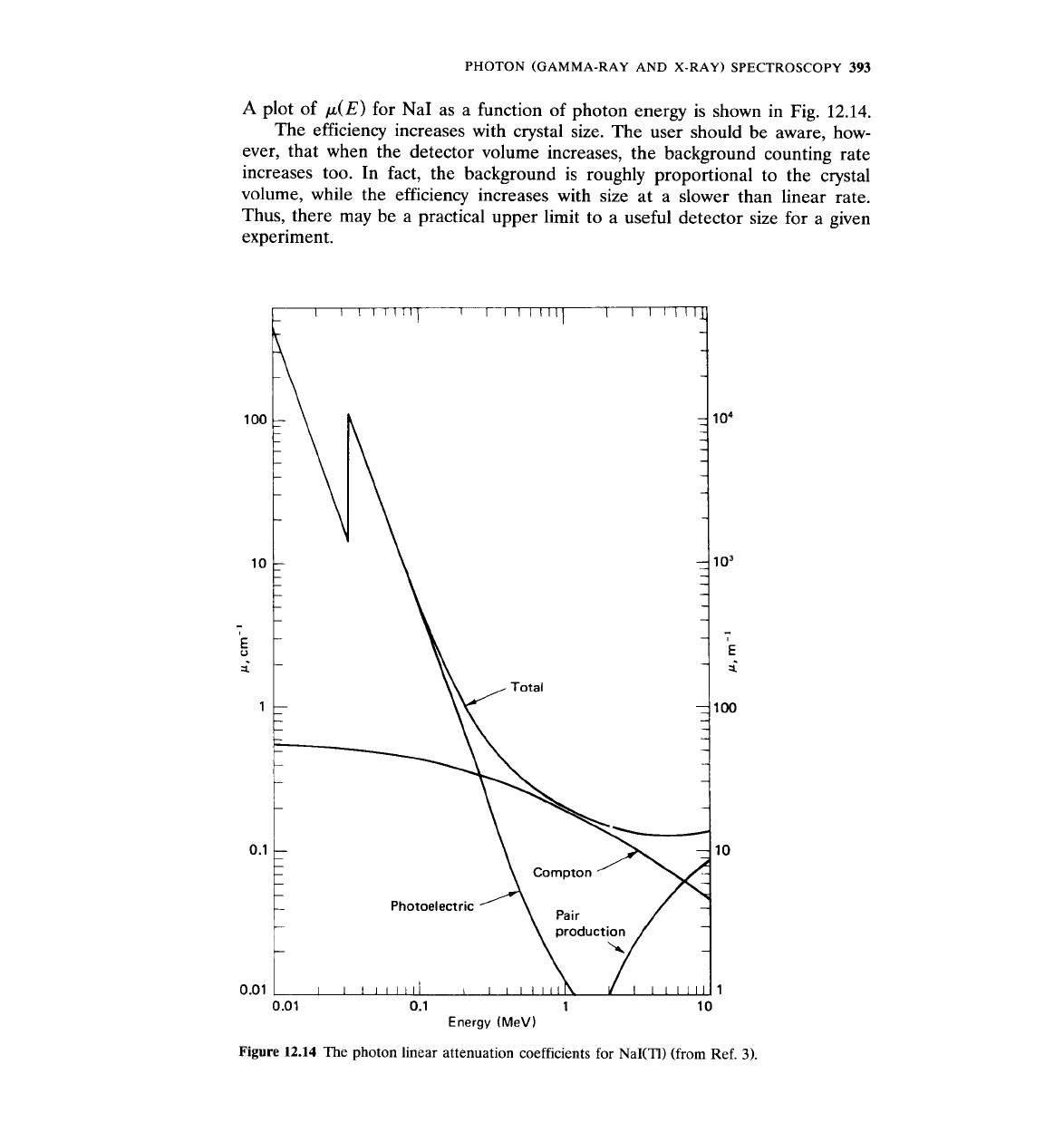
PHOTON
(GAMMA-RAY
AND
X-RAY)
SPECTROSCOPY
393
A
plot of
EL(E)
for NaI as a function of photon energy is shown in Fig.
12.14.
The efficiency increases with crystal size. The user should be aware, how-
ever, that when the detector volume increases, the background counting rate
increases too. In fact, the background is roughly proportional to the crystal
volume, while the efficiency increases with size at a slower than linear rate.
Thus, there may be a practical upper limit to a useful detector size for a given
experiment.
0.01 0.1 1
Energy
(MeV1
Figure
12.14 The photon linear attenuation coefficients for NaI(TI) (from Ref.
3).
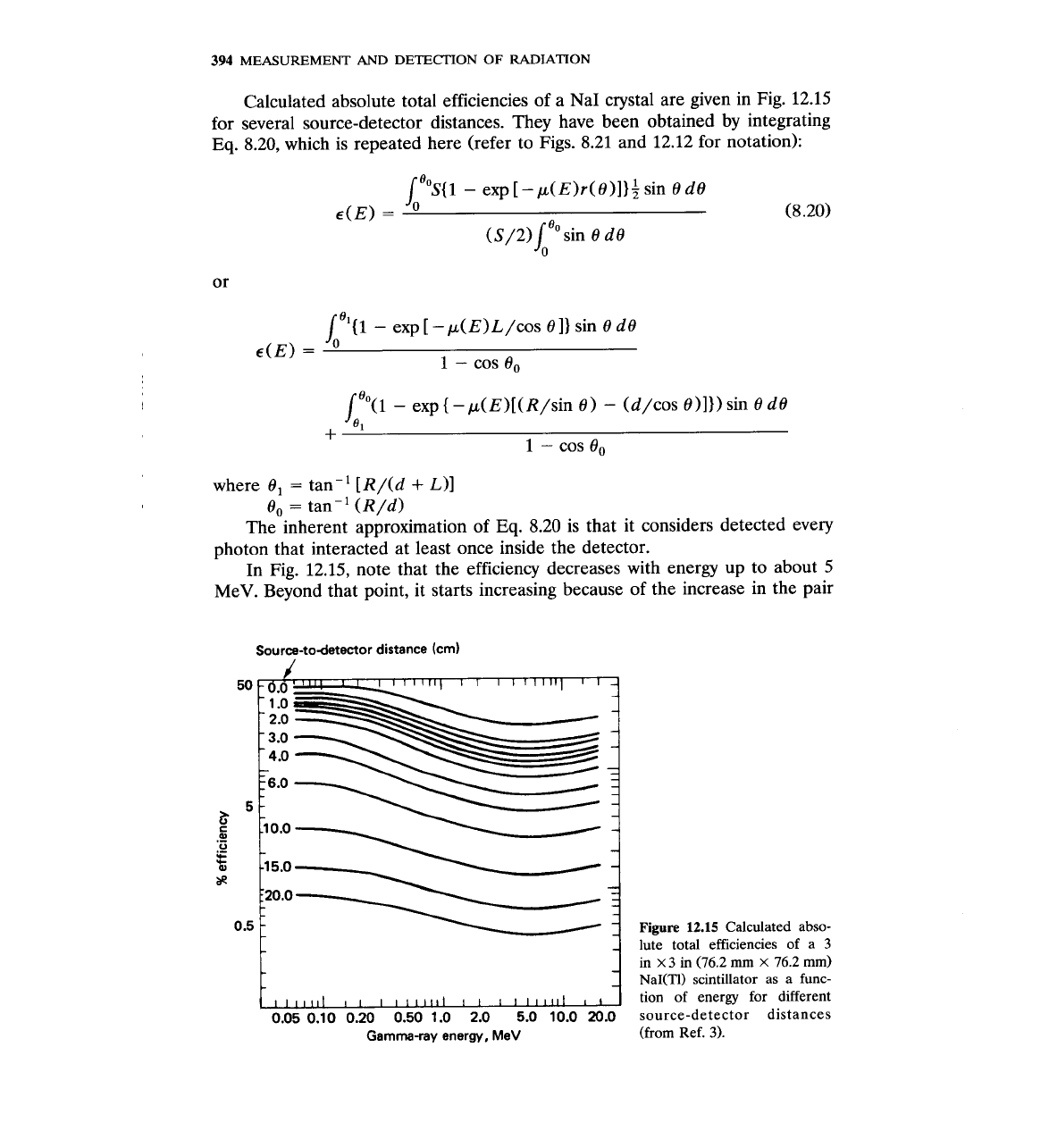
394
MEASUREMENT AND DETECTION OF RADIATION
Calculated absolute total efficiencies of a NaI crystal are given in Fig. 12.15
for several source-detector distances. They have been obtained by integrating
Eq.
8.20, which is repeated here (refer to Figs. 8.21 and 12.12 for notation):
"(1
-
exp [-p(E)L/cos 61) sin 6 dB
E(E)
=
1
-
cos
8,
where 6,
=
tan-' [R/(d
+
L)]
6,
=
tan-' (R/d)
The inherent approximation of
Eq.
8.20 is that it considers detected every
photon that interacted at least once inside the detector.
In Fig. 12.15, note that the efficiency decreases with energy up to about 5
MeV. Beyond that point, it starts increasing because of the increase in the pair
Source-todetector distance (cm)
0.5
Gamma-ray energy, MeV
Figure 12.15
Calculated abso-
lute total efficiencies of a
3
in
x
3
in (76.2 mm
X
76.2 mm)
NaI(T1) scintillator as
a
func-
tion of energy for different
source-detector distances
(from Ref.
3).
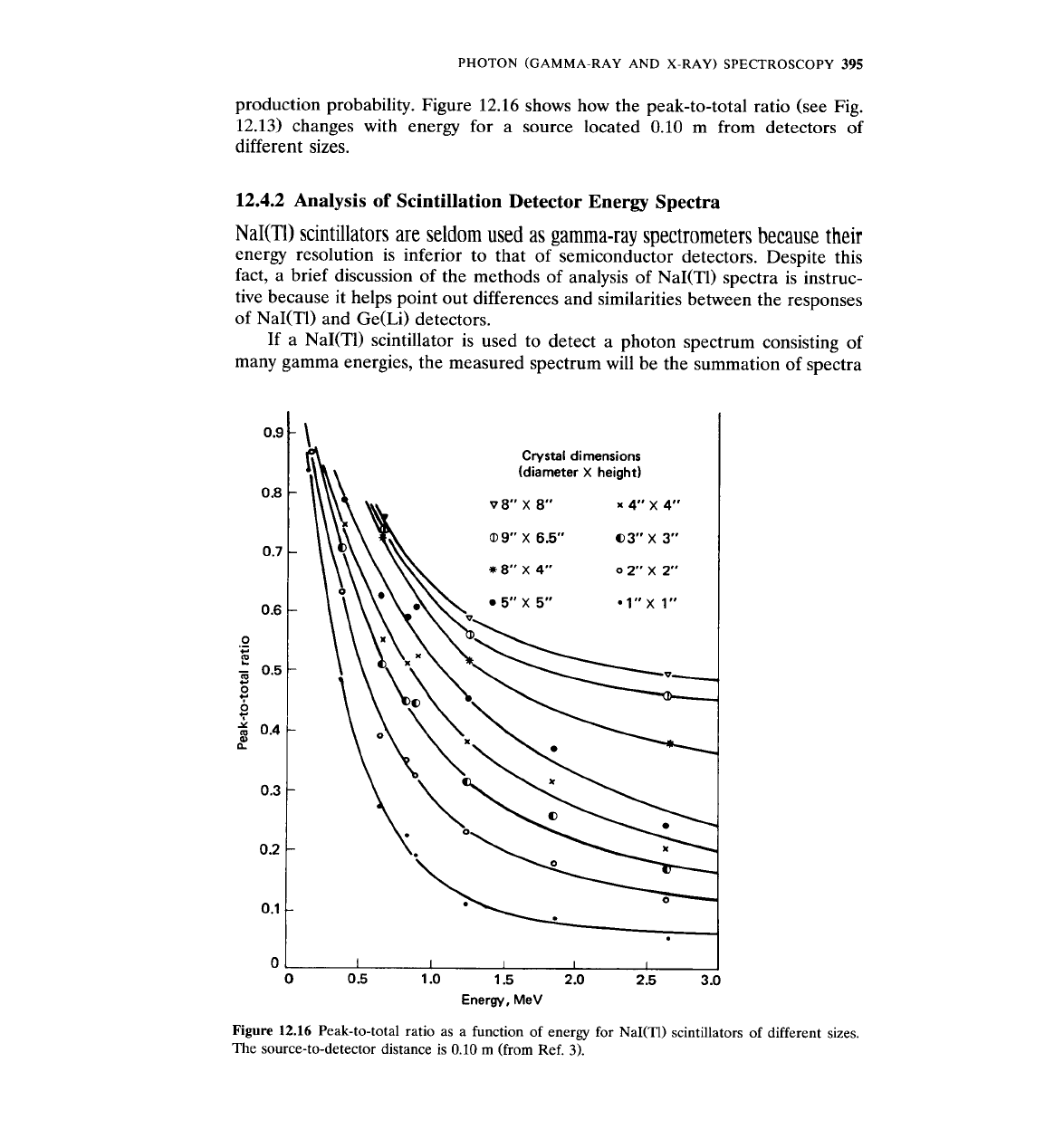
PHOTON
(GAMMA-RAY
AND
X-RAY)
SPECTROSCOPY
395
production probability. Figure 12.16 shows how the peak-to-total ratio (see Fig.
12.13) changes with energy for a source located
0.10
m from detectors of
different sizes.
12.4.2
Analysis
of
Scintillation Detector Energy Spectra
NaI(T1) scintillators are seldom used as gamma-ray spectrometers because their
energy resolution is inferior to that of semiconductor detectors. Despite this
fact, a brief discussion of the methods of analysis of NaI(TI) spectra is instruc-
tive because it helps point out differences and similarities between the responses
of NaI(T1) and Ge(Li) detectors.
If
a
NaI(T1) scintillator is used to detect a photon spectrum consisting of
many gamma energies, the measured spectrum will be the summation of spectra
Crystal dimensions
(diameter
X
height)
v
8"
x
8"
x
4"
x
4"
a9"
X
6.5"
Q3"
X
3"
0
2"
x
2"
I
I
I
I
I
0.5
1
.O
1.5 2
.O
2.5
3
.O
Energy, MeV
Figure 12.16
Peak-to-total ratio as a function of energy for
NaI(T1)
scintillators of different sizes.
The source-to-detector distance is
0.10
m (from Ref.
3).
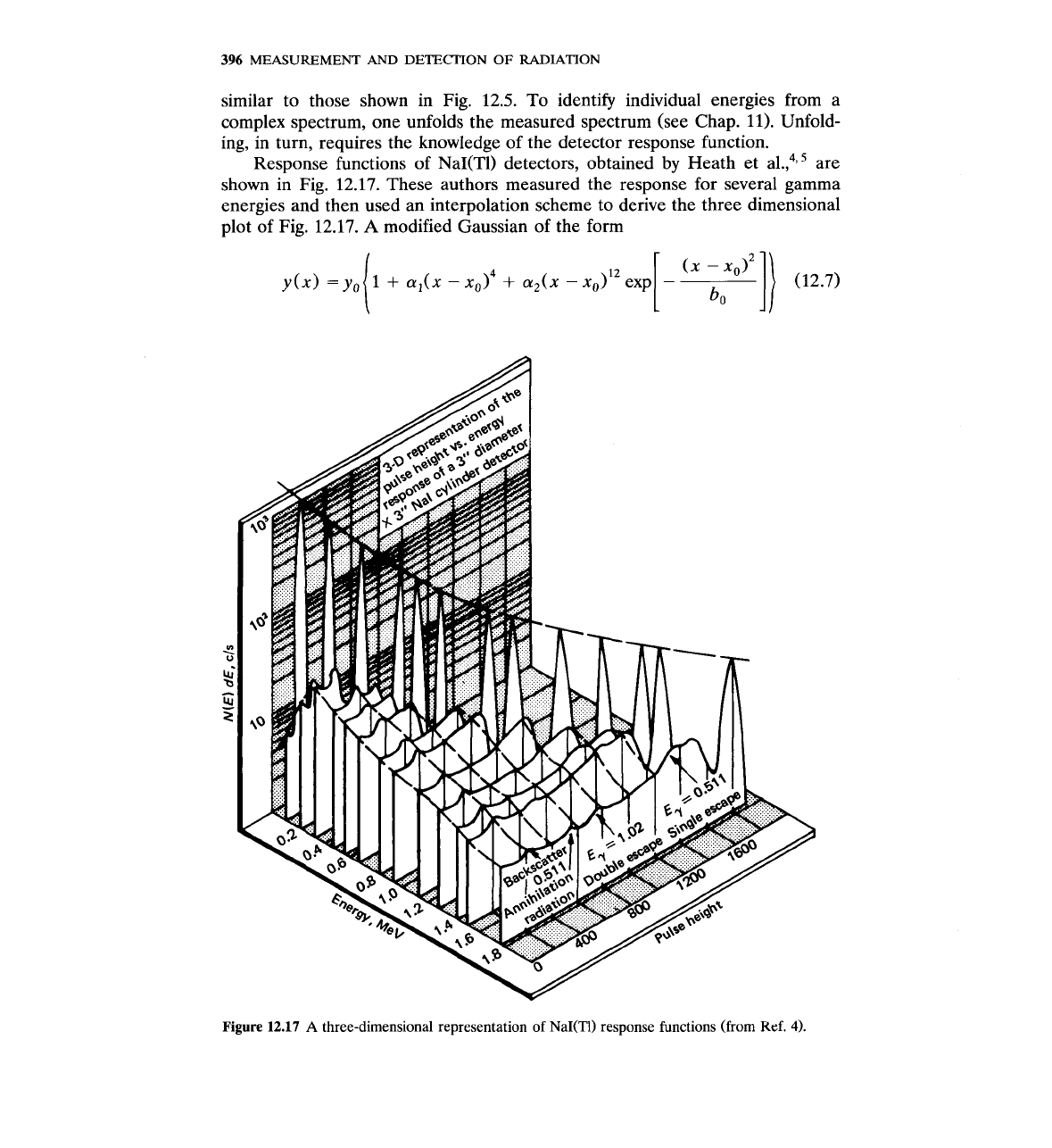
396
MEASUREMENT AND DETECTION OF RADIATION
similar to those shown in Fig. 12.5. To identify individual energies from a
complex spectrum, one unfolds the measured spectrum (see Chap. 11). Unfold-
ing, in turn, requires the knowledge of the detector response function.
Response functions of NaI(T1) detectors, obtained by Heath et al.,4,5 are
shown in Fig. 12.17. These authors measured the response for several gamma
energies and then used an interpolation scheme to derive the three dimensional
plot of Fig. 12.17.
A
modified Gaussian of the form
Figure
12.17
A
three-dimensional representation of
NaI(T1)
response functions (from Ref.
4).
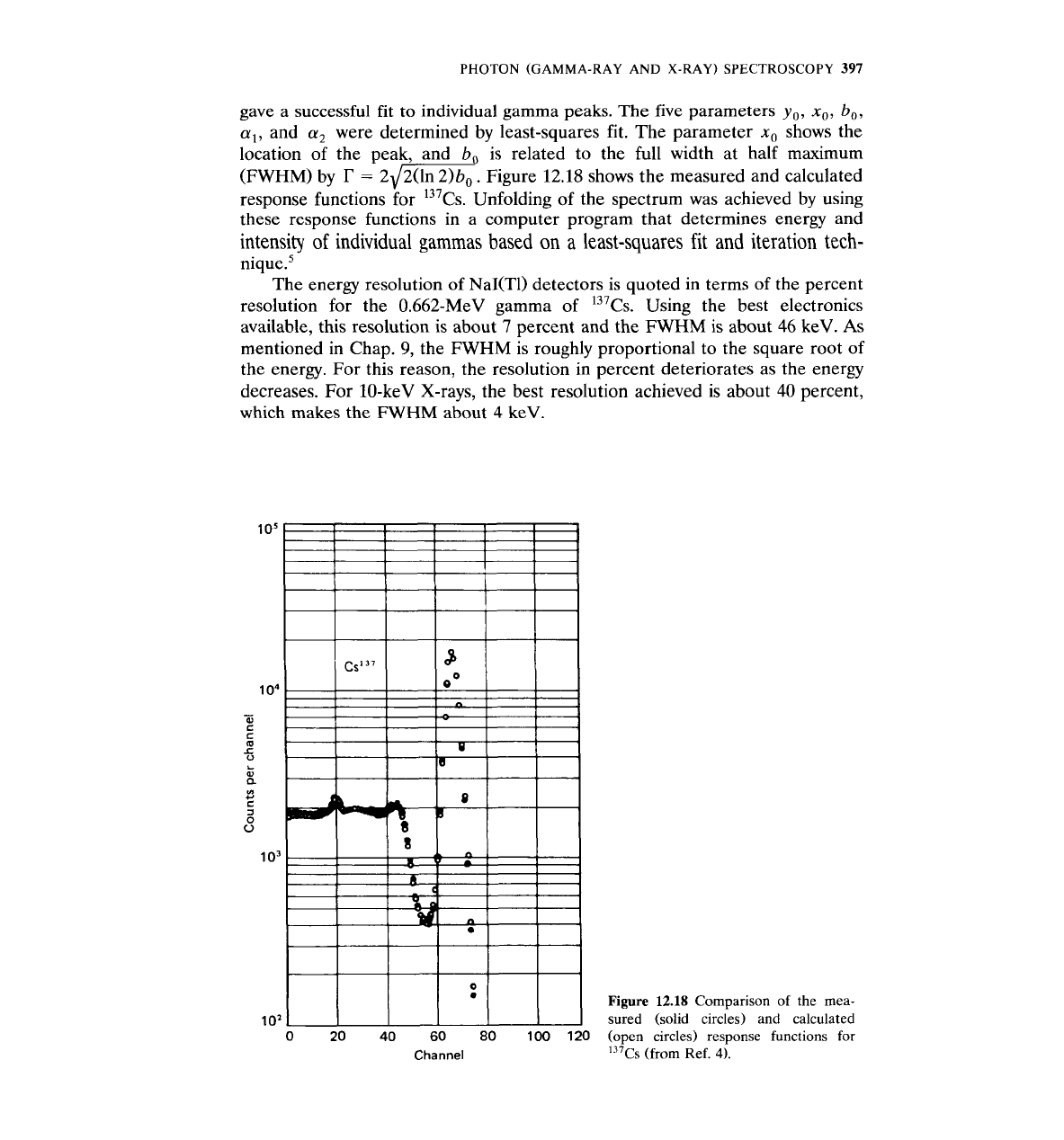
PHOTON
(GAMMA-RAY
AND
X-RAY)
SPECTROSCOPY
397
gave a successful fit to individual gamma peaks. The five parameters
yo,
x,,
b,,
a,,
and
a,
were determined by least-squares fit. The parameter
x,
shows the
location of the peak, and
b
is related to the full width at half maximum
n 2)b Figure 12.18 shows the measured and calculated
(FWHM)
by
=
2d2(1.
response functions for '37~s. Unfolding of the spectrum was achieved
by
using
these response functions in a computer program that determines energy and
intensity of individual gammas based on a least-squares fit and iteration tech-
niq~e.~
The energy resolution of Nal(T1) detectors is quoted in terms of the percent
resolution for the 0.662-MeV gamma of
137~s. Using the best electronics
available, this resolution is about
7
percent and the FWHM is about
46
keV. As
mentioned in Chap.
9,
the FWHM is roughly proportional to the square root of
the energy. For this reason, the resolution in percent deteriorates as the energy
decreases. For 10-keV X-rays, the best resolution achieved is about 40 percent,
which makes the FWHM about
4
keV.
Figure
12.18
Comparison of the mea-
sured (solid circles) and calculated
0 20
40
60 80
100
120
(open circles) response functions for
Channel
'"CS
(from Ref.
4).
